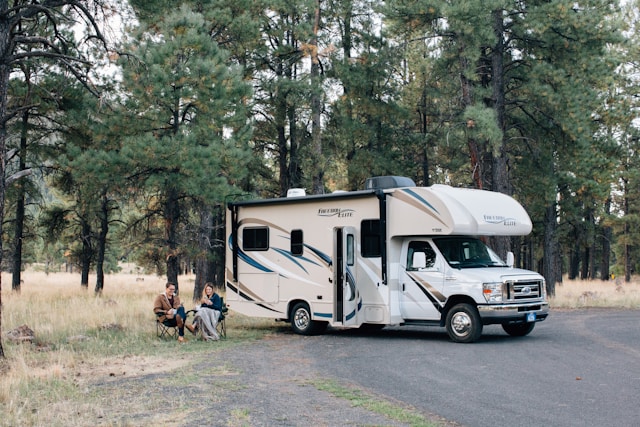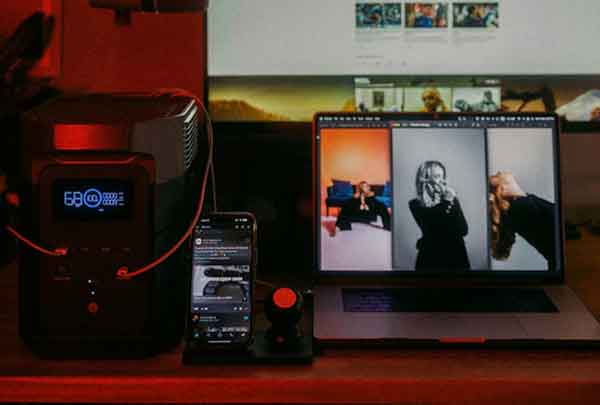Somehow we all know the feeling – your phone dies just before you get the opportunity to snap the perfect sunset at your campsite, or your camera battery gets drained the minute you see wildlife. Smartphones & portable devices have changed the way we experience life – they are essential; however, it is difficult to keep them charged while exploring the great outdoors. This is where solar generators come in – the life-changing answer to campers who want a way to make sure they have power during their outdoor adventure that is both reliable and sustainable.
Solar-powered: These ingenious devices utilize the sun’s energy to provide clean, quiet power wherever your adventures take you. Unlike noisy gas generators, solar generators are safe for indoor use, do not produce fumes, and are completely silent. If you’re a weekend warrior or looking for a longer-term off-grid solution, solar power systems can help your devices function properly.
In this ultimate guide, we’ll explain everything there is to understand about portable solar generators for camping. You’ll learn everything from what the technology is about, on how to choose the perfect system for your needs … and more, on how to power your outdoor experience in an environmentally friendly way. We’ll delve into both systems that can charge small devices (like phones and tablets) and more substantial systems that can power electrical devices (like power tools and compact fridges).
Understanding Portable Solar Generators
At the core of each portable solar generator is a complex network of interconnected parts that work together in perfect harmony. The solar panels are the main energy collectors; they utilize the photovoltaic cells to convert sunlight into D.C. (Direct Current) electricity. This stored energy is fed to a charge controller, which controls the pace of charging and prevents the battery from overcharging. That energy is then stored in a battery (typically lithium-ion) and later converted back from DC to alternative current (AC) by an inverter, allowing the power to be used by your devices.

Unlike conventional gasoline generators, solar generators don’t require fuel, maintenance, clean up, installation, and do not emit toxic fumes or noise. They have no parts to replace, do not require fuel, and can be operated safely inside a tent or RV. The technology provides real renewable energy freedom and can produce power as long as the sun shines. This environmentally friendly approach also allows for a secure power supply without the recurring cost and the logistical nightmare of fuel transportation/storage.
Why Solar Generators Excel for Camping
Solving Outdoor Power Challenges
With the advent and continuing evolution of portable solar generators, our approach to power management in the field has changed considerably. They are completely plug and play, which means they remove the hassle from setting up traditional power for beginners and more experienced campers. These systems stow down small for travel and have you up and running in minutes, providing that much-needed power even in the most remote camping locations. Several models have more than one charging port, so you can charge your phone, tablet, camera, or other gadgets at the same time without needing to juggle adapters or take turns.
Beyond Basic Power Needs
And while keeping smartphones charged is a big deal, solar generators really earn their worth when powering things that matter. Major manufacturers such as EcoFlow have created systems that consistently serve medical equipment like CPAP (continuous positive airway pressure) machines in a way that allows campers with health conditions to trek in the wild comfortably. In a pinch, when the weather is hard to predict, they can be crucial for emergency backup systems, working radios, lights, and small heating appliances. Modern-day solar generators can even power heavier loads such as a portable refrigerator, an electric cooker, or a coffee machine, giving the old-school camping experience a massive upgrade to outdoor living.
Choosing Your Ideal Solar Generator
Sizing Your Power Solution
Knowing the amount of power you require is an essential step to choosing the perfect solar generator. Begin by compiling a list of your vital devices, along with their wattage needs. A smartphone or tablet can charge on 5 to 7 watts, a laptop on 45 to 100 watts. CPAP machines typically use 30-60 watts, and portable fridges can consume a continuous 40-60 watts. Determine how much power you need each day by multiplying the wattage of each device by the number of hours you will use it. For weekend getaways, you’ll want a generator with a minimum of 500 watt-hours, while week-long adventures may demand in excess of 1000 watt-hours for keeping things comfortably charged.
Critical Features Comparison
Weight is very important when moving your solar generator to distant campsites. Less powerful low-weight units are available (3-7 lbs) for simple charging for backpackers to 20-30 lb systems for heavy weight, extensive charge on site-base camp applications. Search for versatile output – multiple USB outputs for devices, AC outlets for small appliances or large electronics, and 12V outputs for lights and other outdoor lawn equipment. You can also enjoy convenience on newer devices with the wireless charging pads.
Some models are better than others at charging directly from the sun. The high-end generators’ charging efficiency is around 80-90% with compatible panels, while the low-quality brands are only around 50-60%. Look at models with MPPT charge controllers for maximum solar harvesting, particularly in unpredictable weather. Daisy chaining multiple solar panels will significantly drop its recharge time; however, that (as you might guess) increases the system cost and complexity.
Top Solar Generator Setups for Campers
For ultralight backpackers, compact solar generators weighing under 10 pounds offer essential power without compromising mobility. These systems typically provide 200-300 watt-hours of capacity – perfect for charging phones, headlamps, and GPS devices. Most feature integrated handles and weatherproof construction, making them ideal companions for trail adventures.
Whether you are backpacking or family car camping, bigger needs arise when it comes to integrating your RV. 500-1000Wh mid-range level systems do well in such situations, providing multiple device support as well as the ability to run small appliances like a coffee maker or a portable cooktop. These models may feature RV-ready plugs or have enhanced display systems for monitoring your power use in real-time. Our expandable solar capacity led to an even quicker charge, and a new feature was a basecamp providing charging storage.
For extended off-grid stays, heavy-duty solar generators delivering 2000+ watt-hours provide comprehensive power independence. These powerhouses can run full-size refrigerators, induction cooktops, and multiple high-draw devices simultaneously. While heavier, their wheeled designs and ergonomic handles maintain reasonable portability.
Step-by-Step Setup & Usage Guide
Field Deployment Process
Your solar generator is ready to be deployed; simply find a clear opening facing south for top sun exposure. Position your solar panels at a 30-45 degree angle, varying a bit with your latitude and the seasons. Make sure all cable connections are clean and snug, and protect connections at vulnerable areas from moisture with weatherproof caps, if available. Ensure polarity matches before connecting panels; plugging in the bulkhead connectors is all that is required to connect two of these panels together.
Power Management Tips
To get the most out of your solar generator, try to charge it up during those hours when the sun’s overhead (from about 10 a.m. to 2 p.m.). Check your battery level on the display and decide exactly how much flow you need according to your desired usage. Critical healthcare devices and urgent communications should be prioritized over convenience. If the sun is lacking, exercise power-saving measures, such as using appliances on airplane mode, dimming screens, and charging big devices during the day when you can pull in the most solar energy. Try plugging into a power strip that has an on/off switch to beat the phantom power draw of modern electronics.
Maintenance & Safety Protocols
Routine maintenance will keep your solar generator at peak performance and working perfectly in an outdoor environment. Wash solar panels with a mild soap solution and a soft microfiber cloth once a month, and avoid using abrasive cleaners that may scratch them. Look over cable connections for signs of wear and/or moisture damage, and make sure all the ports are clean. Please place the generator in a temperature environment of 32-104℉ (0-40℃) to avoid damage to the battery cells or keep the charge between 40-80% during long-term storage.
Keep it simple and take care of your investment with these basic safety practices. Never allow the generator to come in contact with direct rain or standing puddles of water, unless weatherproof rain covers are being used. When the unit is operating, ensure that there is adequate air space around the unit to avoid overheating. Do not discharge the battery to 20% initially; this will increase the battery life. When camping in cold weather, locate the generator in the shade in hot weather and insulate during cold weather. During winter camping, heat the generator in advance of use, and take the batteries in the tent at night to keep them warm for better performance.
Powering Your Outdoor Adventures
Adopting portable solar generators isn’t just a nice camping power solution – it’s the doorway to real outdoor freedom! These clever devices have changed the way we go off-grid forever – no longer do we fret about dead devices and are armed with the means to stay connected to the modern world. Using the cleanest, most sustainable energy around, we can venture further, stay longer, and camp in greater comfort than ever before.
Whether you’re a weekend camper who wants to keep their phone running during a camping trip, or an off-grid warrior powering a full campsite, solar generators offer unmatched freedom and reliability. Their whisper-quiet operation maintains outdoor silence and prevents both campers and wild animals from becoming aware of your presence. With solar technology continuing to improve, these portable power stations can only get better and stronger.
Get a step closer to energy independence on your next outdoor vacation. With the ideal solar generator, you wouldn’t have to miss recording those winning shots or stress over powering crucial appliances. Join the ranks of those who accept nothing less than the best: Rubicon’s Hunters & Anglers.




Leave a Reply